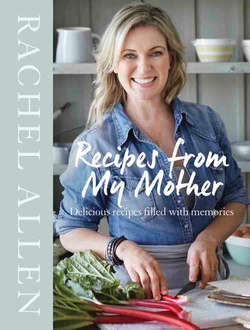Читать книгу Recipes from My Mother - Rachel Allen - Страница 37
ОглавлениеChicken stock
MAKES 1.5–2 LITRES (2½–3½ PINTS) STOCK
I always have a pot of chicken stock on the go. When you’re using good chickens for roasting or braising, it’s crazy not to boil up the bones afterwards. There’s an old South American proverb that says, ‘Good broth will resurrect the dead,’ and it’s not far wrong as the nutritional content of a homemade stock indeed has miraculous qualities if eaten regularly. Our great-grandmothers were right after all.
1 whole chicken carcass, raw or cooked
1 large leek, cut into 4 pieces
2 celery sticks, each cut into 4 pieces
2 carrots, each cut into 4 pieces
2–4 garlic cloves, to taste, peeled
1 bouquet garni (a few sprigs of parsley, 1 or 2 sprigs of thyme and a small bay leaf)
a few black peppercorns
pinch of sea salt
1. Preheat the oven to 200°C (400°F), Gas mark 6. Place the chicken bones in a roasting tin and cook in the oven for 15 minutes. The roasting stage is optional but I love the slightly stronger, more enhanced flavour that it gives the final broth.
2. Once the bones are roasted (see tips), transfer them to a large saucepan and add the leek, celery, carrots and garlic cloves. Pop in the bouquet garni and black peppercorns, then cover generously with cold water – adding about 2 litres (3½pints). The water must be cold since, while it’s slowly heating up, it will draw the flavour and goodness out of the vegetables and the bones.
3. Bring to the boil, then turn the heat down and simmer for 2 hours, skimming off and discarding any foam that rises to the surface.
4. Once it’s cooked, strain the broth through a fine sieve, then leave to stand to allow the fat to rise to the top. Skim off the fat and season the broth with salt to taste.
TIPS
If there are any bits of meat or little caramelised nuggets of flavour stuck to the roasting tin after cooking the chicken bones, place the tray over a medium heat on the hob, pour in a small glass of water and, using a whisk, scrape to dissolve the bits. Pour these into the saucepan too.
I’ve found that if I leave the fat sitting on top of the stock while it’s in the fridge there are two added bonuses – once the fat is chilled it’s far easier to lift it off the stock; and the stock keeps for longer (a few weeks rather than just a few days) in the fridge if completely covered in the fat. Remove the fat before use.
